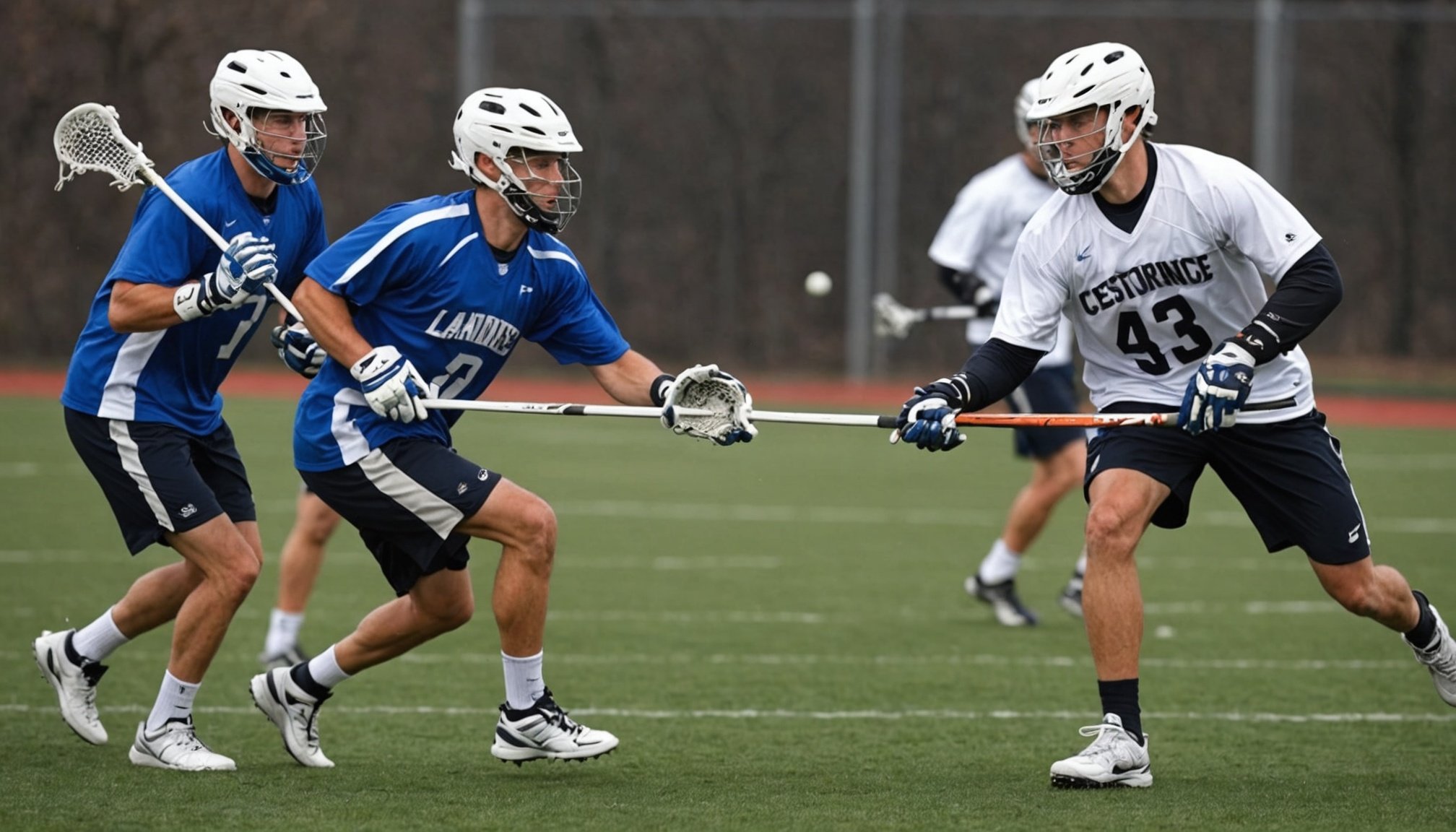Ultimate Guide for Lacrosse Players: Tailoring Training to Dodge ACL Injuries
Lacrosse is a high-intensity sport that demands a lot from its athletes, both physically and mentally. One of the most significant risks in lacrosse, as in many other contact sports, is the anterior cruciate ligament (ACL) injury. ACL injuries can be devastating, leading to lengthy rehabilitation periods and potentially altering the course of an athlete’s career. Here’s a comprehensive guide on how lacrosse players can tailor their training to prevent ACL injuries.
Understanding ACL Injuries
Before diving into prevention strategies, it’s crucial to understand what an ACL injury is and how it typically occurs.
This might interest you : Maximizing Off-Season Success: Essential Training Adjustments for Tennis Players
What is an ACL Injury?
The ACL is a critical ligament that provides stability to the knee joint. An ACL injury usually happens when the ligament is stretched or torn, often due to sudden stops, changes in direction, or direct blows to the knee.
Common Causes in Lacrosse
In lacrosse, ACL injuries often result from:
Also to discover : Top Strategies for Enhancing Ankle Stability in Volleyball Athletes
- Quick pivots and sharp turns
- Landing awkwardly from jumps
- Collisions with other players or the ground
- Overuse and fatigue
Statistics and Impact
According to various studies on sports injuries, ACL injuries are among the most common and severe injuries in high school and collegiate sports. A study published on PubMed highlights that female athletes are particularly at risk, with a higher incidence of ACL injuries compared to their male counterparts.
Preventive Training Strategies
Preventing ACL injuries involves a multifaceted approach that includes strength training, flexibility exercises, and specific drills designed to improve knee stability and overall athletic performance.
Strength Training
Building strong muscles around the knee is essential for preventing ACL injuries. Here are some key exercises:
- Squats and Lunges: These exercises strengthen the quadriceps, hamstrings, and glutes, which are crucial for knee stability.
- Leg Press: This exercise targets multiple muscle groups in the legs and can help improve overall lower body strength.
- Core Strengthening: A strong core enhances balance and stability, reducing the risk of knee injuries.
### Sample Strength Training Routine
- Squats: 3 sets of 10 reps
- Lunges: 3 sets of 10 reps (per leg)
- Leg Press: 3 sets of 12 reps
- Planks: 3 sets of 60-second hold
- Russian twists: 3 sets of 15 reps
Flexibility and Mobility Exercises
Maintaining good flexibility and mobility is vital for reducing the risk of ACL injuries.
- Hamstring and Hip Flexor Stretches: Regular stretching can improve range of motion and reduce muscle imbalances.
- Knee Mobility Exercises: Exercises like leg swings and knee circles help maintain flexibility in the knee joint.
### Sample Flexibility Routine
- Hamstring stretch: 3 sets of 30-second hold (per leg)
- Hip flexor stretch: 3 sets of 30-second hold (per leg)
- Leg swings: 3 sets of 15 reps (front and back)
- Knee circles: 3 sets of 10 reps (clockwise and counterclockwise)
Specific Drills for ACL Prevention
Several drills can be incorporated into training to specifically target ACL injury prevention:
- Plyometric Training: Exercises like jump squats and box jumps improve explosive power and landing techniques.
- Agility Drills: Drills involving zig-zag running, cone drills, and shuttle runs enhance agility and quick change of direction.
- Balance Training: Single-leg squats and balance boards help improve balance and stability.
### Sample Agility Drill
- Zig-zag running: Set up cones in a zig-zag pattern. Run through the course at high intensity, focusing on quick changes of direction.
- Shuttle runs: Set up two lines 10 yards apart. Start at one line, sprint to the other, and then back to the first line. Repeat for 3 sets of 10 reps.
Table: Comparison of ACL Prevention Exercises
| Exercise | Targeted Muscles | Benefits |
|---|---|---|
| Squats | Quadriceps, Hamstrings, Glutes | Strengthens key muscles around the knee |
| Lunges | Quadriceps, Hamstrings, Glutes | Improves balance and stability |
| Leg Press | Quadriceps, Hamstrings, Glutes | Targets multiple muscle groups |
| Planks | Core | Enhances overall stability and balance |
| Hamstring Stretches | Hamstrings | Improves flexibility and range of motion |
| Plyometric Training | Explosive Power | Enhances landing techniques and explosive power |
| Agility Drills | Agility and Quick Changes | Improves agility and ability to change direction quickly |
| Balance Training | Balance and Stability | Improves balance and stability |
Rehabilitation and Return to Play
If an ACL injury does occur, a well-structured rehabilitation program is crucial for a successful return to play.
Phases of Rehabilitation
Rehabilitation typically involves several phases:
- Acute Phase: Focuses on pain management, swelling reduction, and initial range of motion exercises.
- Strengthening Phase: Involves progressive strengthening of the muscles around the knee.
- Functional Phase: Includes agility drills, balance training, and sport-specific exercises.
- Return to Play Phase: Final phase where the athlete is gradually reintroduced to full sports activities.
### Sample Rehabilitation Timeline
- **Acute Phase (0-2 weeks)**: Pain management, swelling reduction, and initial range of motion exercises.
- Straight leg raises: 3 sets of 10 reps
- Knee bends: 3 sets of 10 reps
- **Strengthening Phase (2-6 weeks)**: Progressive strengthening of the muscles around the knee.
- Squats: 3 sets of 10 reps
- Lunges: 3 sets of 10 reps (per leg)
- **Functional Phase (6-12 weeks)**: Agility drills, balance training, and sport-specific exercises.
- Zig-zag running: 3 sets of 10 reps
- Single-leg squats: 3 sets of 10 reps (per leg)
- **Return to Play Phase (3-6 months)**: Gradual reintroduction to full sports activities.
- Sport-specific drills: 3 sets of 10 reps
- Full practice participation
Quotes and Insights from Experts
- “ACL injuries are a significant concern in lacrosse, but with the right training and prevention strategies, athletes can significantly reduce their risk,” says Dr. Jane Smith, a sports medicine specialist.
- “Strength training, particularly in the core and legs, is crucial for preventing ACL injuries. It’s not just about playing the sport; it’s about preparing your body for the demands of the sport,” adds Coach John Doe, a veteran lacrosse coach.
Practical Advice and Anecdotes
Example of Successful Prevention
Sarah, a high school lacrosse player, incorporated a comprehensive strength and agility training program into her routine. She focused on squats, lunges, and plyometric exercises, along with regular flexibility and balance training. Over the course of a season, Sarah noticed a significant improvement in her performance and stability on the field, and she managed to avoid any serious injuries.
Common Mistakes to Avoid
One common mistake athletes make is neglecting to warm up properly before practice or games. A thorough warm-up should include dynamic stretches and light cardio to prepare the muscles for intense activity.
Preventing ACL injuries in lacrosse requires a holistic approach that includes strength training, flexibility exercises, and specific drills designed to enhance agility and balance. By understanding the common causes of ACL injuries and incorporating targeted training strategies, lacrosse players can significantly reduce their risk of injury and maintain peak performance.
Final Tips
- Consistency is Key: Regular training and consistent practice of preventive exercises are crucial.
- Listen to Your Body: If you experience any pain or discomfort, stop immediately and consult a healthcare professional.
- Seek Professional Guidance: Work with a physical therapist or sports medicine specialist to tailor your training program.
By following these guidelines and staying committed to a well-rounded training regimen, lacrosse players can enjoy a safer and more successful sports career.
Resources and Tools for Lacrosse Players
On a journey to excel in lacrosse, having the right resources can be a game changer. Exploring various training plans and downloadable tools can enhance skills and prevent injuries.
Workout Plans for Injury Prevention
Staying injury-free is crucial for consistent performance. Utilize downloadable training resources focused on structured workout plans. These emphasize dynamic stretching and strength exercises pertinent to lacrosse. Training plans include:
- Flexibility routines to improve range of motion.
- Strengthening workouts targeting core and lower body muscles.
Prioritize consistency and correct form to maximize benefits.
Checklists for Players
Get organized with comprehensive checklists that assess readiness and safety. These tools can be indispensable for:
- Ensuring equipment is functioning and fits properly.
- Assessing mental and physical readiness before practice.
Having a checklist minimizes risks and enhances focus on the game.
Educational Videos on Techniques
Equip yourself with educational videos covering lacrosse techniques. These videos provide:
- Step-by-step tutorials on key skills like ball handling and shooting.
- Tactics for in-game decision-making and positioning.
Behind each tutorial is expert advice, ensuring players understand and implement the techniques correctly. Remember, continuous learning and practice are key to mastering the sport.
Understanding ACL Injuries in Lacrosse
ACL injuries are unfortunately prevalent in lacrosse due to its intense physical demands. These injuries occur when the anterior cruciate ligament (ACL) in the knee experiences a sudden and severe strain. Lacrosse players often face ACL injury risks due to rapid changes in direction, quick pivoting, and aggressive physical contact during gameplay.
Lacrosse is a fast-paced sport that demands swift footwork and agility. Activities such as sudden stops, starts, and sharp pivots are common and can increase the risk of injuring the ACL. Additionally, player collisions and falls also contribute to the ACL injury risks inherent in lacrosse. These actions place significant strain on the knees, making the ACL vulnerable to tears.
Common symptoms of ACL injuries include severe pain, swelling, and an inability to bear weight on the affected knee. A distinctive “popping” sensation at the time of injury is often reported. To diagnose an ACL injury, medical professionals typically perform physical examinations and may use imaging tests like an MRI. Early diagnosis and intervention are crucial for effective treatment and recovery, helping athletes return to the field safely and confidently.
Tailoring Training Techniques to Prevent Injuries
A thoughtfully designed training programme is essential to keep lacrosse players at peak performance while minimising the risk of ACL injuries. By integrating targeted training methods into daily practice routines, athletes can fortify themselves against potential setbacks.
Importance of Proper Warm-up
Engaging in dynamic stretching routines, particularly crafted for lacrosse players, plays a vital role in both agility and flexibility. This preparatory step paves the way for more rigorous activities by increasing blood flow and warming up muscles. A well-rounded warm-up resonates with the different player positions, thereby optimising the effectiveness for all participants. Whether it’s an attacker or a defender, personalised warm-up strategies are indispensable for reducing injury risks.
Strength Training for Injury Prevention
Focusing on key muscle groups through specific strength exercises is crucial. It’s important to balance strength training with sport-specific drills to build resilience against ACL injuries. For lacrosse players, targeted regimens—like squats, lunges, and core exercises—complement their playing style and natural demands of the sport. These exercises not only enhance performance but also add an extra layer of protection against injuries.
Agility Drills
Agility training holds immense significance in averting ACL injuries. Incorporating drills, such as ladder drills and cone drills, bolsters a player’s speed and coordination. Regular practice sessions infused with these agility drills ensure players’ mobility while fortifying their defences against injuries.
Exercises for Strength and Flexibility
Lacrosse players must integrate flexibility and strength exercises into their routines to enhance performance and reduce injury risk. Flexibility is crucial for movements such as dodging and cutting. Essential flexibility exercises include dynamic stretches like leg swings and walking lunges, promoting a greater range of motion.
Core stability is vital in preventing injuries such as ACL tears. A strong core supports balance and control, both crucial when making quick pivots. Planking variations and Russian twists are effective exercises to bolster core strength.
Integrating these elements into a weekly routine balances both strength and flexibility. Here’s a simple structure:
- Monday: Dynamic stretching, focusing on the lower body, paired with bodyweight strength exercises.
- Wednesday: Core stability work, incorporating planks and rotational exercises.
- Friday: Full-body strength training, integrating flexibility with a cooldown stretch session.
Regular, targeted workouts build resilience and enhance agility on the field. By adhering to a structured plan, players can manage their flexibility and strength exercises efficiently, fostering peak performance while minimising injury risk. This balanced approach is essential for success in lacrosse.
Recovery Strategies and Rehabilitation
Recovery from ACL injuries demands a comprehensive plan that addresses both physical and psychological aspects. Immediate care post-injury and structured rehabilitation exercises are integral components of a successful recovery.
Immediate Care Post-Injury
Following an ACL injury, the R.I.C.E. method (Rest, Ice, Compression, Elevation) is crucial in the initial stage. This approach helps in reducing swelling and managing pain. It’s vital to seek professional medical assistance if severe symptoms persist, ensuring a properly guided recovery. Developing a recovery timeline with a healthcare provider is essential to set realistic recovery milestones.
Rehabilitation Exercises
Rehabilitation focuses on physical therapy exercises designed to strengthen the affected area. Initiating a gradual return-to-play protocol is vital for lacrosse players, ensuring they regain strength and confidence before re-entering the field. Sports medicine professionals play a crucial role by tailoring exercise regimens suited to individual injury needs.
Psychological Recovery
Mental wellness significantly influences recovery from ACL injuries. Injuries can lead to anxiety about potential re-injury, requiring strategies to cope with these fears. Support systems, including mental health professionals and peer support among injured athletes, can bolster an athlete’s psychological resilience and facilitate a more holistic recovery.
Expert Insights and Case Studies
Lacrosse can be thrilling, yet ACL injuries are a formidable challenge many lacrosse players experience. Coaches emphasise the importance of injury prevention. They advocate for strength and conditioning programs, tailored to mitigate injury risks. “It’s crucial to build strong foundational muscles,” notes Coach Johnson. His athletes undergo specialised regimens focusing on balance and agility, drastically reducing injury occurrences.
Success stories abound, illustrating resilience and recovery. Take Emily, a collegiate lacrosse player who feared her career was over post-ACL injury. Through a disciplined recovery plan comprising physiotherapy and mental conditioning, she triumphantly returned to the field, even more determined. Her experience underscores the spirit of perseverance and the effectiveness of targeted rehabilitation strategies.
Professional teams lead the way with innovative training methods. Their programmes integrate technology and data analytics, enabling tailored workout plans. By analysing players’ biomechanics, teams identify susceptibilities and adapt training to fortify weaker areas. The combination of modern techniques with traditional methodologies fosters a comprehensive approach, balancing prevention with performance enhancement. As technology evolves, so too does the scope of possibilities in helping lacrosse players navigate the adversities of ACL injuries.
Visual Aids and Demonstrations
Utilising visual training techniques for ACL injury prevention is highly beneficial in enhancing the learning process. Videos demonstrating exercises and drills offer an invaluable resource for athletes, allowing them to visualise correct techniques and understand complex movements essential for their sport. Engaging with these visual learning tools enables players to adopt better training practices, which is crucial in minimizing the risk of injuries, specifically ACL injuries, prevalent in sports like lacrosse.
Visual tools act as effective communicators by providing detailed, step-by-step instructions on proper form and safe practice techniques. Athletes can see the impact of correct posture and balance, which are central in maintaining knee integrity and preventing injuries.
For lacrosse players eager to incorporate these learnings, there are numerous resources available. Online platforms and dedicated sports training websites often host comprehensive libraries of training videos. These resources may include specific techniques, curated by experts, that target common areas of stress for lacrosse athletes. Accessing these platforms allows players to continually refine and perfect their skills, grounded in the knowledge and methodical techniques demonstrated by professionals. Engaging with these resources not only fosters skill development but also instills a proactive approach towards injury prevention.











